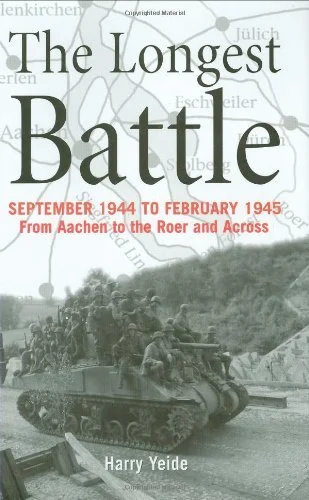The longest battle
Finalist, U.S. Army Historical Foundation’s 2005 Distinguished Writing Awards.
*********
This comprehensive study of the battle to clear the German Army out of the area west of the Roer River covers the period from September 1944 to February 1945.... There are stories of supreme scarifice, heroic actions and the bone-numbing, foot-slogging of the infantry.... Officers and enlisted men are quoted from interviews, letters and personal diaries."
Richard G. Laporte, "Military," November 2005
*********
"The Longest Battle is a comprehensive account of the strategic decisions, small unit actions, intense combat, and catastrophic losses Allied forces endured as they fought their way into the German heartland.
The book uses personal diaries, after-action reports, and unit histories to develop the history of this epic little-known struggle. The book is more than a narrative of the events during this campaign; it integrates the personal triumphs and tragedies of individual Soldiers and their leaders as they fight and eventually win the struggle.
For today’s warriors, the Roer River Campaign is an outstanding example of what intense warfare in complex, difficult terrain involves while fighting an extremely capable enemy."
Maj. Jeffrey L. LaFace, USA
Military Review, Jan-Feb 2006
**********
Here's the official scoop:
In the early afternoon of September 12, 1944, an American patrol entered Nazi Germany southwest of the ancient city of Aachen. Three months after the landing at Normandy, the Allies were finally within reach of the enemy on his home turf. Among the troops there was even talk of getting home for Christmas. What followed, though, was one of the most grueling campaigns of the warthe nearly six-month-long battle fully recounted for the first time in this powerful work. Combining stirring narrative and meticulous historical detail, The Longest Battle provides a complete and compelling account of what happened after the first breach of the Third Reich by Allied ground combat forces: of the troops terrible struggle across the Siegfried Line, Hitlers vaunted West Wall, through the benighted Hurtgen Forest, and across the Roer. The strategic decisions and setbacks, the incremental advances, and catastrophic losses that marked this still-controversial but critically important battle unfold in all their historical, military, and human significance in Harry Yeides bookfinally filling a gap in our understanding of World War II.
Format: Hardbound
Pages: 304
Length: 6w x 9h
ISBN: 0760321558
Catalog ID: 139441AP
************
Here's a bit more:
Nearly half a year passed from the time that the Roer River first became an operational objective at the division level in September 1944 to the day American troops swarmed across its racing waters in February 1945. There were Allied strategic objectives--including the Rhine River--that were on the books for longer periods. But no other place in Western Europe featured for so long in the plans and efforts of the men who controlled the daily activities of the GIs, tankers, tank destroyer crews, combat engineers, and other soldiers who actually fought and won the war. The same might be said for the Landsers, Grenadiere, Fallschirmjäger, and Panzertruppen on the German side.
"The Longest Battle" offers a sweeping view from the strategic level down to the experiences of individual soldiers and draws heavily on original sources such as after-action reports. The work also draws substantially from accounts written just after the war by German officers for the US Armys historical division.
The work has some bias toward the Allied perspective. As the Allies held the initiative, the organizational structure is built mainly on stages in their campaign to cross the Roer River. At the same time, it strives to give fair representation and treatment to the German view of the struggle. The unequal weight in lower-level unit reports and personal anecdotes from the two sides results from the author having access to richer sources on the Allied experience.
Appendices provide divisional order of battle for key units on both sides, equivalent military ranks, and a glossary. There are maps and photographs, many drawn from US Army Signal Corps film and German newsreels and almost certainly never before published.
